Intel Core M-5Y70

インテル Core M-5Y70 2025年:このプロセッサーを搭載したノートパソコンを選ぶべきか?
導入:ウルトラモビリティを重視する
インテル Core M-5Y70は、2014年から2015年にかけて発売されたプロセッサーで、ウルトラブックの時代の象徴となりました。その主な特徴は、最小限の電力消費(TDP 4.5W)とパッシブ冷却です。しかし、10年後の2025年にこのプラットフォーム上のデバイスを考慮すべきでしょうか?詳細を見ていきましょう。
アーキテクチャとプロセス技術:コンパクトさはパフォーマンスの犠牲に
Broadwellの特徴
プロセッサーは、インテルの第5世代Coreマイクロアーキテクチャ「Broadwell」で、14nmプロセスで製造されています。これは、インテルがウルトラポータブルデバイス向けにTDPを削減することに注力した進化の最初のステップです。
- コアとスレッド:2コア、4スレッド(ハイパースレッディング)。ベースクロックは1.1GHz、ターボモードは最大2.6GHz。
- グラフィックス:Intel HD Graphics 5300(24EU、クロック100–800MHz)。DisplayPort経由で4Kをサポート。
- キャッシュ:L3キャッシュは4MB。
これは何を意味するか? Core M-5Y70は呼び出された段階でも高性能志向ではなく、アクティブ冷却なしで基本的なタスクを提供することを目的としています。
電力消費とTDP:静かさと自律性
TDP 4.5W:利点と欠点
この非常に低い熱パッケージにより、ファンなしでノートパソコンを製造することが可能になりました。たとえば、レノボのYoga 3 ProやAppleのMacBook 12インチ(2015年)は、同様のアプローチを採用していました。
- 利点:
- 完全無音。
- ケースの重量と厚さの減少。
- 欠点:
- 長時間の負載時にパフォーマンスが制限される(スロットリング)。
重要:2025年には、インテル Core i5-1230U(9W)やApple M2(20W)などの現代のプロセッサーはTDPが高いですが、その効率はCore M-5Y70を大きく上回ります。
パフォーマンス:2025年のCore M-5Y70は何ができるか?
実際の使用シナリオ
- オフィス業務:
- 文書作成(Word、Excel)、ブラウザ(5-10タブ) — 受け入れ可能だが、バックグラウンドアプリを起動すると遅延することがあります。
- ビデオ通話(Zoom、Teams) — 基本的な品質には足りるが、背景フィルターは使用できません。
- マルチメディア:
- ストリーミング4K(YouTube、Netflix) — ハードウェアアクセラレーションによるデコードのおかげで対応可能。
- 写真編集(Lightroom) — 軽い補正のみに適します。
- ゲーム:
- 古いゲーム(Half-Life 2、Minecraftの低設定) — 20-30 FPS。
- 現代のプロジェクト — 推奨されません。
ターボブーストモード:短時間の負荷時にはクロックが2.6GHzに上昇しますが、1-2分後にはスロットリングが始まります。たとえば、Handbrakeでの動画レンダリングは、Core i5の12世代の4-3倍の時間がかかります。
使用シナリオ:Core M-5Y70は誰に向いているか?
理想のユーザー層
- 学生:講義、メモ、PDF作業用。
- 旅行者:軽量ノートパソコン(1-1.3kg)で、8-10時間のバッテリー駆動。
- セカンダリデバイス:主なPCの補助としてアウトドア作業用。
向いていない:
- ゲーマーやビデオ編集者。
- 重たいIDEユーザー(Android Studio、Unity)。
例:Core M-5Y70搭載のDell XPS 13(2015年)は、リファービッシュ市場で$150–200で見つけられます。しかし、$300–400でIntel N100(2023)ベースのデバイスが入手でき、それは2倍の性能を持っています。
自律性:バッテリーはどれくらい持つか?
省エネ技術
- インテル SpeedShift:ダイナミックなクロック管理により、低消費モードへの迅速な移行が可能。
- C-ステート:未使用のコアを無効にする。
実際の使用:
- ウェブサーフィン時 — 7-9時間(バッテリー40-50Wh)。
- 動画視聴時 — 最大6時間。
アドバイス:2025年には、こうしたデバイスのバッテリーはしばしば劣化しています。購入前にバッテリー状態を確認してください。
競合との比較:過去と現在
2015年の類似製品
- インテル Core i5-5200U(Broadwell、15W):マルチスレッドタスクで30-40%高速ですが、アクティブ冷却が必要です。
- AMD A6-8500P(Carrizo-L、15W):シングルスレッドテストで劣りますが、グラフィックスは優れています。
現代の代替品(2025年)
- インテルプロセッサー N100(Alder Lake-N、6W):4コア、3.4GHz、TDP 6W。Core M-5Y70の2-3倍の速度。
- Apple M1(2020):シングルスレッドパフォーマンスは3倍、高速マルチスレッドは6倍。
結論:Core M-5Y70は基本的なタスクですら古くなっており、正当化されるニッチは超低価格デバイスに限られます。
長所と短所:能力のバランス
強み
- 静音性とコンパクトさ。
- 4K動画のサポート。
- 中古市場での低価格。
弱み
- CPUとGPUの低パフォーマンス。
- 負荷時のスロットリング。
- 現代の標準への非対応(USB-C、Thunderbolt 4、Wi-Fi 6Eなし)。
ノートパソコン選びの推奨事項
2025年に何を重視するか?
1. デバイスのタイプ:ウルトラブックまたは2-in-1コンバーチブル。ゲーミングやワークステーションは避けるべき。
2. RAM:最低8GB。4GBのモデル(例:Asus UX305FA)は、既にWindows 11には不適切。
3. ストレージ:SSDのみ。HDDは基本的な作業を遅くします。
4. 価格:適正価格を超えないように。新しい予算のノートパソコン(例:HP Pavilion Aero 13、Ryzen 5 7530U搭載)は$500–600で現代の技術を提供します。
失敗例:$250での中古MacBook 12インチ(2015年)購入。$100追加してリファービッシュのiPad 9 + キーボードを購入した方が良いです。
最終結論:Core M-5Y70は誰に向いているか?
このプロセッサーは、次のようなニーズのある人に最適です:
- テキストとインターネット用の超低価格ノートパソコン。
- 静音でパッシブ冷却のデバイス。
- 旅行用の予備ガジェット。
2025年の主な利点:
- $200未満で入手可能。
- (バッテリーが交換されている場合)実証済みの信頼性。
制限:
- 現代のOSに必要な高い要件には適さない(Windows 11、macOS Sonoma)。
結論:ノスタルジーか合理性か?
インテル Core M-5Y70は、ウルトラブックの時代の遺物であり、2025年には特別な場合にのみ関連性があります。予算が厳しく、タスクが最小限である場合は検討できますが、快適な作業のためには現代のプロセッサーを選んだ方が良いでしょう。技術は進歩しており、今日では$300–400でCore M-5Y70を全ての面で上回るデバイスを収得できます。
基本
CPUの仕様
メモリ仕様
GPUの仕様
その他
ベンチマーク
他のCPUとの比較
ソーシャルメディアで共有する
または当サイトへのリンクを追加
<a href="https://cputronic.com/ja/cpu/intel-core-m-5y70" target="_blank">Intel Core M-5Y70</a>